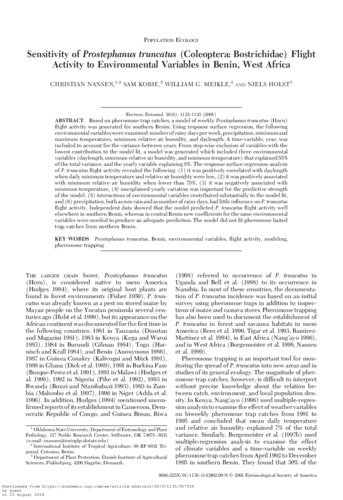Sensitivity of Prostephanus truncatus (Horn) (Coleoptera:Bostrichidae) flight activity to environmental variables in Benin, West Africa
Abstract
Based on pheromone trap catches, a model of weekly Prostephanus truncatus (Horn) flight activity was generated for southern Benin. Using response surface regression, the following environmental variables were examined: number of rainy days per week, precipitation, minimum and maximum temperatures, minimum relative air humidity, and daylength. A time-variable, year, was included to account for the variance between years. From step-wise exclusion of variables with the lowest contribution to the model fit, a model was generated which included three environmental variables (daylength, minimum relative air humidity, and minimum temperature) that explained 55% of the total variance, and the yearly variable explaining 8%. The response surface regression analysis of P. truncatus flight activity revealed the following: (1) it was positively correlated with daylength when daily minimum temperature and relative air humidity were low, (2) it was positively associated with minimum relative air humidity when lower than 75%, (3) it was negatively associated with minimum temperature, (4) unexplained yearly variation was important for the predictive strength of the model, (5) interactions of environmental variables contributed substantially to the model fit, and (6) precipitation, both as mm rain and as number of rainy days, had little influence on P. truncatus flight activity. Independent data showed that the model predicted P. truncatus flight activity well elsewhere in southern Benin, whereas in central Benin new coefficients for the same environmental variables were needed to produce an adequate prediction. The model did not fit pheromone baited trap catches from northern Benin.

